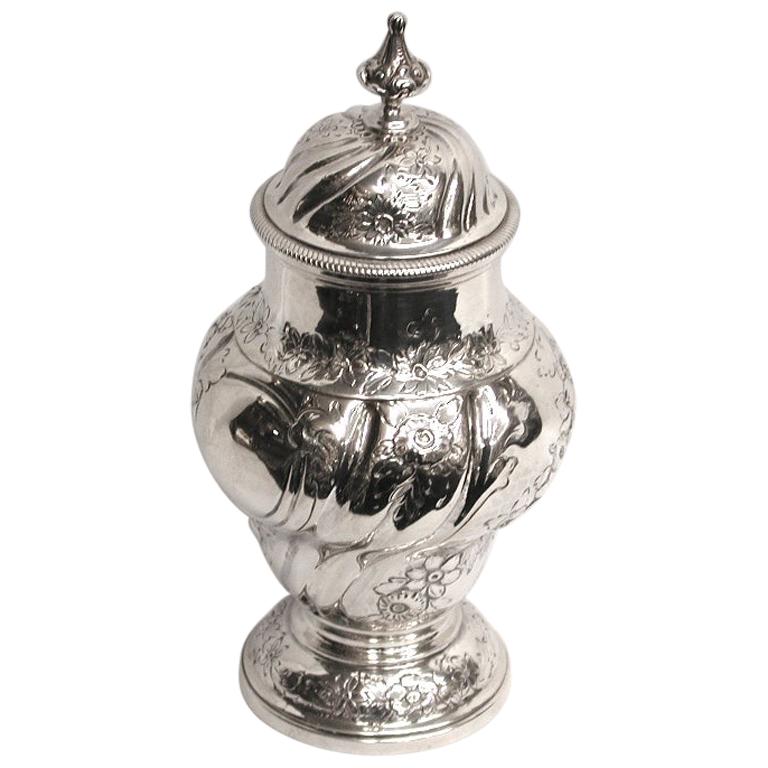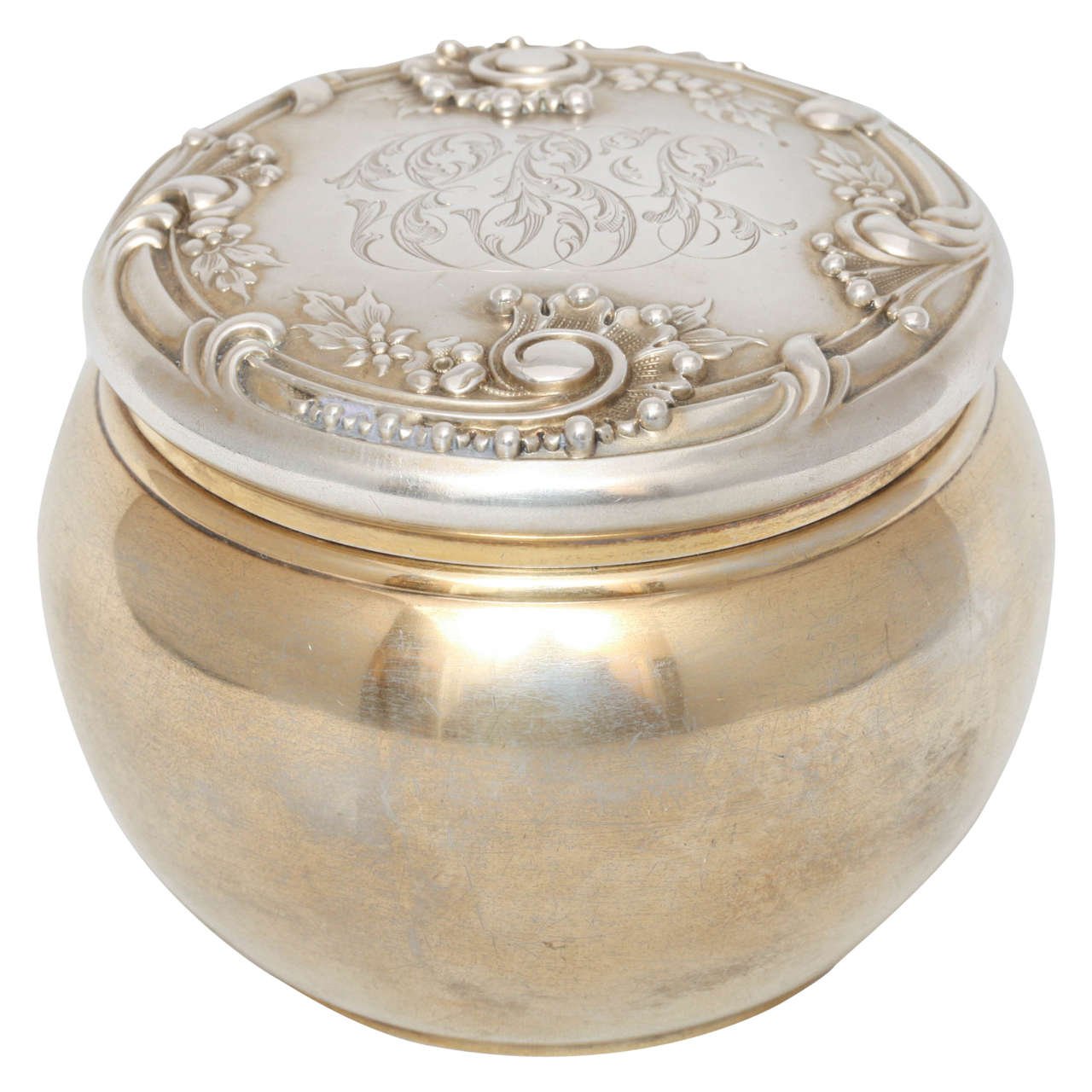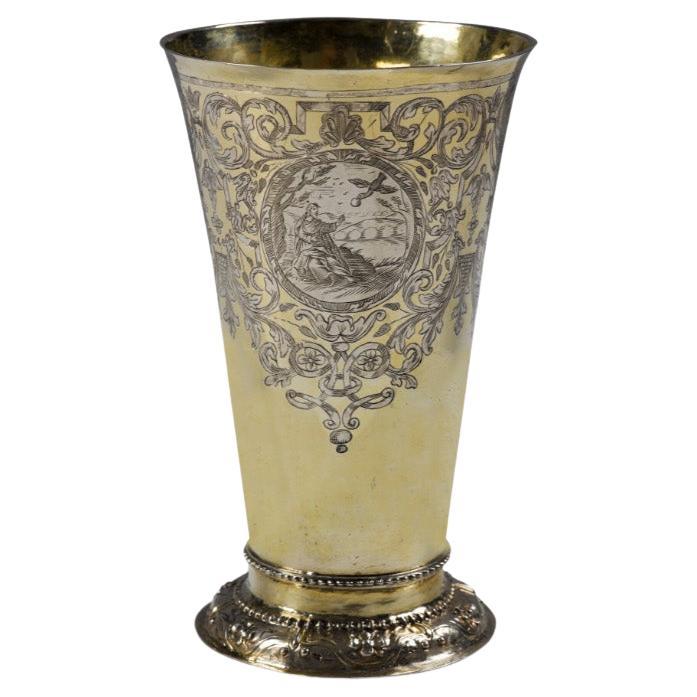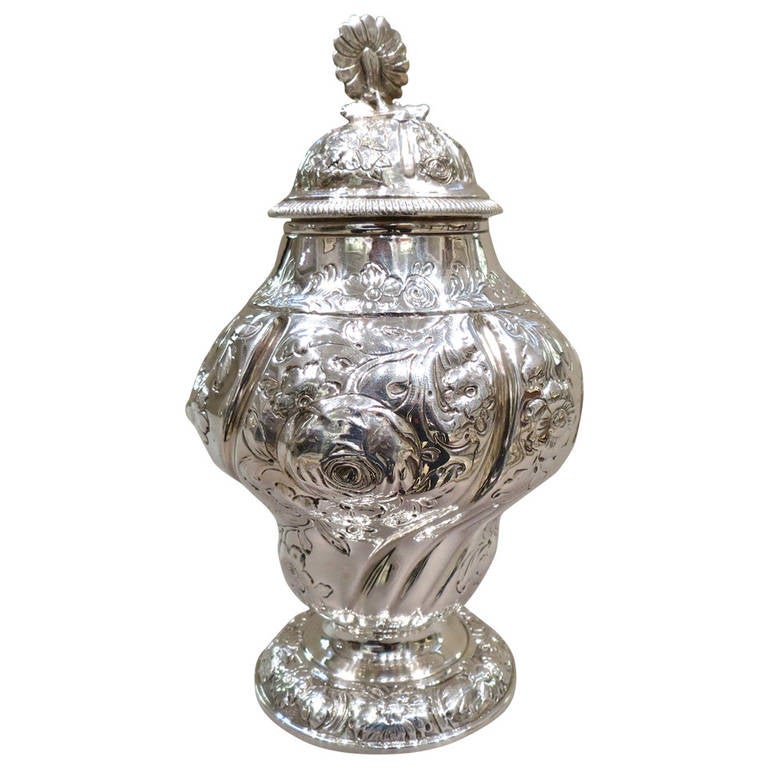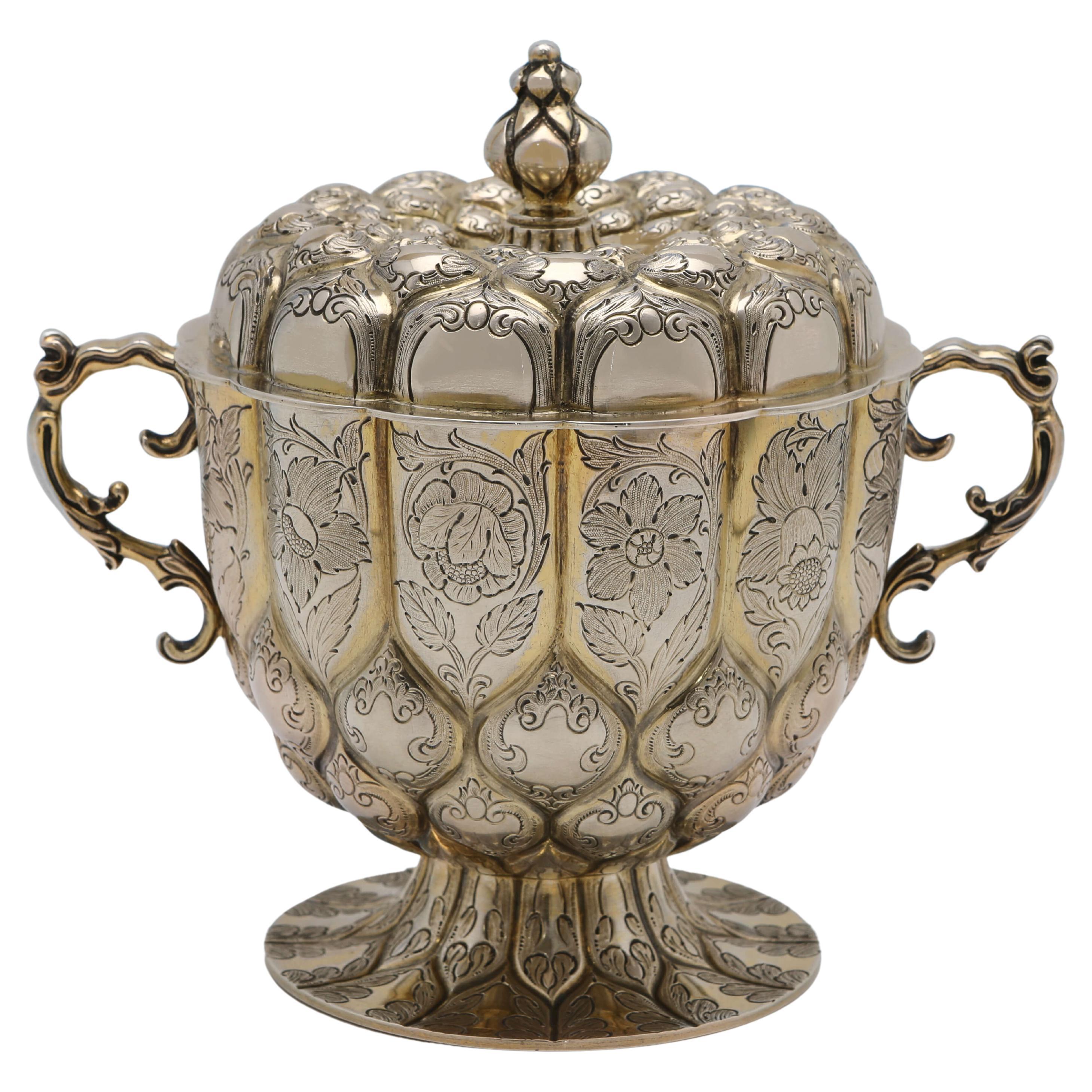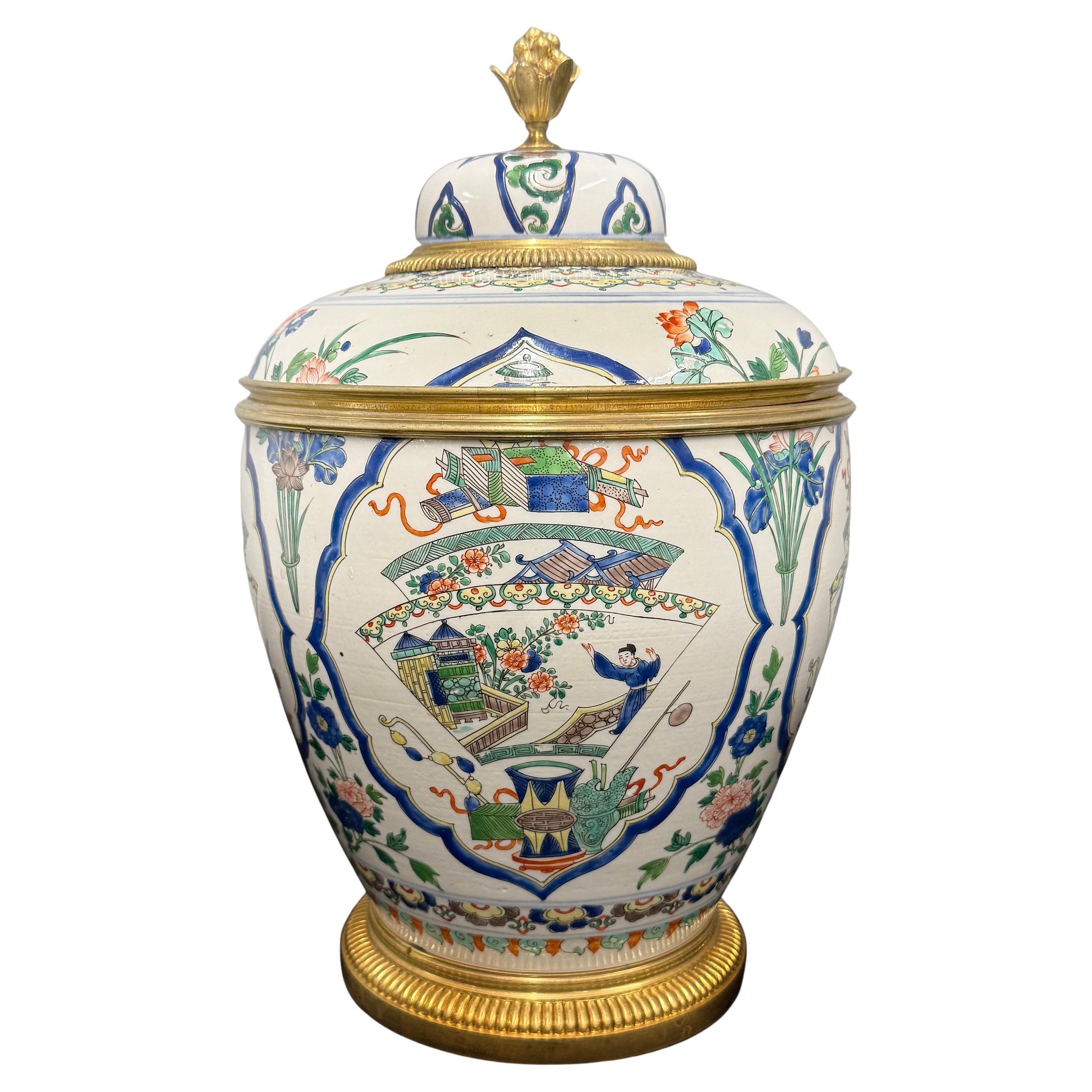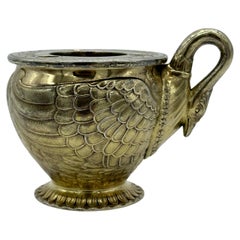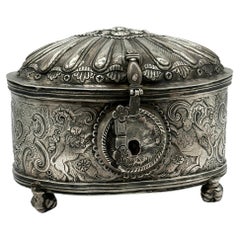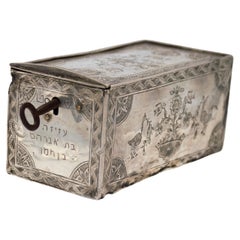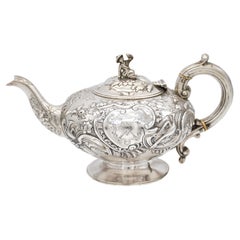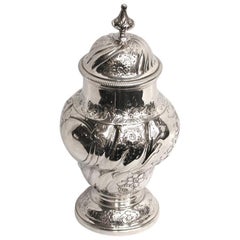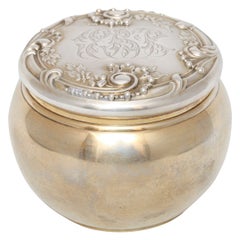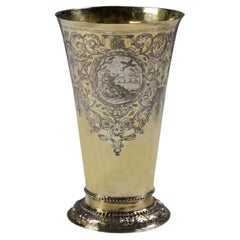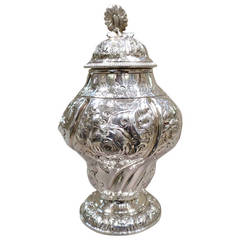Items Similar to Rare German Parcel-Gilt Silver Canister, Abraham Drentwett i, Augsburg 1649-1666
Video Loading
Want more images or videos?
Request additional images or videos from the seller
1 of 10
Rare German Parcel-Gilt Silver Canister, Abraham Drentwett i, Augsburg 1649-1666
$48,000
£36,447.54
€41,680.48
CA$67,062.96
A$74,588.65
CHF 38,947.88
MX$907,664.54
NOK 497,423.81
SEK 466,495.78
DKK 311,077.40
Shipping
Retrieving quote...The 1stDibs Promise:
Authenticity Guarantee,
Money-Back Guarantee,
24-Hour Cancellation
About the Item
Important German parcel-gilt silver canister, Abraham Drentwett I, Augsburg, circa 1649-1666 Abraham Drentwett I is one of Augsburg's foremost silversmiths during the Baroque period. He was Active 1641-1666 , he is best known for having executed Queen Christina's silver throne, Commissioned for her coronation in 1650 by Magnus Gabriel De la Gardie.
It is very rare to find such original works, all marked and in this good of a condition, this canister
Came from a good German collection of early European silver.
Maker's mark: AD For Abraham Drentwett I
City mark: Augsburg, Germany
Assay scrape: Zickzack line (Tremolierstrich)
canister of this size and condition are highly desireable and rare to be found in such original, exceptional condition.
Condition : This rare silver canister is an exceptional gauge of silver, exceptional quality and in original, exceptional condition. The partial gilding has natural wear in keeping with age. The German hallmarks struck to the base. surface of the body and cover are all very clear.
Dimensions
Width 10.6cm/4.2"
Height 16.5cm/6.5"
Weight 492 grams
- Dimensions:Height: 6.5 in (16.51 cm)Width: 4.2 in (10.67 cm)Depth: 4.2 in (10.67 cm)
- Style:Baroque (Of the Period)
- Materials and Techniques:
- Place of Origin:
- Period:
- Date of Manufacture:1649-1666
- Condition:Wear consistent with age and use. Very good condition for its age, no restorations or missing parts, some minor scratches consistent With age.
- Seller Location:Tel Aviv - Jaffa, IL
- Reference Number:1stDibs: LU8130234624962
About the Seller
No Reviews Yet
Vetted Professional Seller
Every seller passes strict standards for authenticity and reliability
1stDibs seller since 2023
- ShippingRetrieving quote...Shipping from: Tel Aviv - Jaffa, Israel
- Return Policy
Authenticity Guarantee
In the unlikely event there’s an issue with an item’s authenticity, contact us within 1 year for a full refund. DetailsMoney-Back Guarantee
If your item is not as described, is damaged in transit, or does not arrive, contact us within 7 days for a full refund. Details24-Hour Cancellation
You have a 24-hour grace period in which to reconsider your purchase, with no questions asked.Vetted Professional Sellers
Our world-class sellers must adhere to strict standards for service and quality, maintaining the integrity of our listings.Price-Match Guarantee
If you find that a seller listed the same item for a lower price elsewhere, we’ll match it.Trusted Global Delivery
Our best-in-class carrier network provides specialized shipping options worldwide, including custom delivery.More From This Seller
View AllRare George iv Gilt-Silver Inkwell, Rundell and Bridge
By Rundell, Bridge & Rundell
Located in Tel Aviv - Jaffa, IL
Very rare and important piece of George IV silver, highly important silver-gilt Inkwell probably by John Bridge of the renowned silversmiths Rundell & Bridge, Royal Silversmiths to t...
Category
Antique 1820s English Sterling Silver
Materials
Gold Plate, Silver
Rare silver Herb Box (Yerbera), Upper Peru, Potosí, c. 1775–90 great repoussé
Located in Tel Aviv - Jaffa, IL
Herb Box (Yerbera), Upper Peru, possibly Potosí, c. 1775–90, cast, repoussé, and chased silver,
the design is very intricate, with lions, cats and some other animals, and a women on the lid, it is made in a shell shape with a classical women on top of the lid, the body is all hand made with lions and wild cats with leafs designs, the inner part is divided into two compartments, as usually in this type of boxes. lock is not working but it is very nice and "primitive" looking.
Boxes have a long history across cultures and time. In Spanish America, containers of many types, styles, and materials were cherished as gifts. Known today as yerberas (herb boxes) or coqueras (coca boxes...
Category
Antique Late 18th Century Snuff Boxes and Tobacco Boxes
Materials
Silver
extremely rare Algerian Judaica silver, jewish Dowry box early 19th century
Located in Tel Aviv - Jaffa, IL
Amazing and scarce JUDAICA object, we have here one of the most touching jewish objects we had for a long time, this small silver dowry box was made in Algeria in the early 19th century, it is all covered with symbols of jewish faith and of couples, the sliding lid has 2 flanking birds with hamsa (protective hand) on each side and a flower vase in the middle.
one side shows two flanking lions with a tree in the middle and the other side shows again two big and two small birds with a flower bowl in the middle, front side has a key hole and next to it there is the Hebrew inscription ס״ט״" which says Siman tov or in English "a good sign" it is taken from the wedding blessing, underneath the lock there is another inscription with the name ״עזיזה בת אברהם בן חמו״ which is the name of the bride, her father and her grandfathers name.
the box is full marked a lot of times with the silversmith mark, every side of the box is marked.
this box was probably ordered by the grooms family to hold the jewelry they are giving to the bride as dowry, this type of objects are rare and there are just a few of them on museum collections.
DOWRY (Heb. נְדֻנְיָה), the property a wife brings to her husband at marriage; the Yiddish equivalent, nadn, is from the same root. The custom of nedunyah became clearly defined and institutionalized only in the talmudic period. In biblical times, mohar (מֹהַר), whereby the groom bought his wife from her father (Gen. 24:53; Ex. 22:15–16; Hos. 3:2), was the accepted practice. It was then customary that the groom give the bride gifts, and that she bring certain property to her husband's home upon marriage: slaves, cattle, real estate, etc. (cf. Gen. 24:59–61; 29; Judg. 1:14ff.; I Kings 9:16). Evidence of the custom of nedunyah is to be found in Tobit (7:14; 8:21) and in the Assuan papyri (Cowley, Aramaic, nos. 15, 18). Gradually, mohar was superseded by the ketubbah custom according to which the husband merely assumed the responsibility of compensation to his wife in case he divorced her: he had to pay her 200 zuzim if she had been a virgin at the time of marriage, and 100 zuzim if a widow or divorcée (see *Ketubbah).
By talmudic times, the institution of nedunyah was prevalent; the father gave a dowry to the bride since the daughter was excluded from paternal inheritance. Fifty zuzim (equivalent to the worth of 180 grams of silver) was the minimum amount a father was obliged to give to his daughter (Ket. 6:5). Parents usually gave much more, according to their social standing. Community funds provided the dowry for an orphan or a very poor girl (ibid.; cf. Sh. Ar., YD 251:8). In case of her father's death, the brothers of a minor girl were obliged to give her the minimum dowry, and the court estimated how much her father would have given her above the minimum dowry. The sum was then taken out of the father's estate and given to the daughter upon majority (Ket. 6:6; 68a–69b). In the absence of such an estimate, each daughter was entitled to receive one-tenth of the value of her father's estate in money, or in valuables (Yad, Ishut, 20:4–7; Sh. Ar., EH 113:4). If the father was unable or unwilling to pay the promised dowry at the betrothal ceremony, the groom could refuse to marry his bride (Ket. 13:5; Ket. 108b–109a). Insistence on exact payment of the promised dowry, however, was frowned upon by later rabbinic authorities (Rema to Sh. Ar., EH 2:1). In certain communities it was customary for the groom's father to make a dowry contribution equal to that of the bride's father (Ket. 102b). The dowry, whether given in real estate, slaves, money, or chattel was recorded in the marriage contract (the ketubbah) and in some instances one-third or one-fifth of the actual value of the dowry was added to the sum mentioned in the ketubbah. Based upon a decree enacted by *Simeon b. Shetah (first century C.E.), the Talmud ruled that the husband and his entire property were liable for compensation as stipulated in the ketubbah, either in case he died (when she collected the sum specified in the ketubbah from the heirs) or in case he divorced his wife (Ket. 82b). For the status of the dowry and the husband's rights and obligations, see below. The rabbinic enactments (Takkanot Shum) by R. Jacob *Tam and by the rabbinic synod of the communities of Speyer, Worms, and Mainz (Germany) stipulated that if a woman died...
Category
Antique Mid-19th Century Algerian Tribal Art
Materials
Silver
Exceptional George III Teapot by Preeminent Silversmith Paul Storr, 1793
By Paul Storr
Located in Tel Aviv - Jaffa, IL
This rare and exceptional George III teapot is the work of preeminent Georgian silversmith Paul Storr, it is one of his earliest works, the date mark on this pieces of the year 1793 which is the first year Storr marked items with his own initials (P S)
The teapot is designed in the neoclassical taste with some Chinese influences, or Chinoiserie taste, though the decoration shows signs of later 19th century enhancement in the technique and style of the chasing.
It is very hard to impossible to find works from this early period with this interesting Royalty provenance.
The family crest on the front is of the Tollemache family, and dating of The teapot indicate It belonged and probably commissioned by or as a gift to William Manners Tollemache, Lord Huntingtower, William, On 12 January 1793, at the Age of 26, he was created a Baronet, of Hanby Hall in the County of Lincoln.
So this teapot was commissioned to celebrate the occasion.
William Manners Tollemache:
Lord Huntingtower (19 May 1766 – 11 March 1833), known as Sir William Manners, Bt, between 1793 and 1821, was a British nobleman And Tory politician.
Born William Manners, he was the eldest son of John Manners and Louisa Tollemache, 7th Countess of Dysart. On 12 January 1793, at the age of 26, he was Ceated a Baronet, of Hanby Hall in the County of Lincoln.On his mother's Succession to the earldom in 1821, he was styled Lord Huntingtower, and adopted The surname of Talmash or Tollemache
Paul Storr:
(baptised 28 October 1770 in London – 18 March 1844 in London) was an English goldsmith and silversmith working in the Neoclassical and other styles During the late eighteenth and early nineteenth centuries. His works range from Simple tableware to magnificent sculptural pieces made for royalty
Paul Storr was England's most celebrated silversmith during the first half of the Nineteenth century and his legacy lives on today. His pieces historically and Currently adorn royal palaces and the finest stately homes throughout Europe and The world. Storr's reputation rests on his mastery of the grandiose neo-Classical Style developed in the Regency period. He quickly became the most prominent Silversmith of the nineteenth century, producing much of the silver purchased by King George III and King George IV. Storr entered his first mark in the first part of 1792, which reflects his short-lived partnership with William Frisbee. Soon after, he Began to use his PS mark, which he maintained throughout his career with only Minor changes. His first major work was a gold font commissioned by the Duke of Portland...
Category
Antique 1790s English Neoclassical Tea Sets
Materials
Silver
Antique early 20th Chinese Exceptional Solid Silver Teapot, Wu Hua物華, Tianjin
Located in Tel Aviv - Jaffa, IL
Antique early 20th Century exceptionally rare Chinese solid silver teapot, of traditional round form, the body finely engraved in traditional Chinese style, suggesting this teapot was made for the Chinese market. The body engraved with bamboo and butterflies , the unusual handle imitating bamboo, the removable lid set with a peach finial (Peaches are the symbol of longevity). According to Daoist lore, the peaches of immortality grew in the garden of the Queen Mother of the West - Xi Wangmu.
the spout with a hedged cover in the shape of a lingzhi mushroom and a FU symbol of good furtune.
the top frieze is decorated with 8 Chinese symbols: a scroll, a Ruyi scepter, a qin, The Endless Knot, a pendant, an old book, a wrist rest, and two overlapping squares.
The teapot is very unusual, fine and exceptionally crisp. it is made of heavy Gauge silver and the attention to detail and design is simply outstanding.
"WU HUA...
Category
Early 20th Century Chinese Chinese Export Metalwork
Materials
Silver
Amazing Japanese silver teapot and cover, dragon spout Meiji period 19TH century
Located in Tel Aviv - Jaffa, IL
amazing rare archaistic style silver ewer or tea pot with cover, the design is Of archaistic style dragons on the main frieze and on the cover, this style came from ancient Chinese a...
Category
Antique 1890s Japanese Metalwork
Materials
Silver
$12,000
Free Shipping
You May Also Like
George 111 Silver Tea Caddy, Dated 1765, London, Benjamin Mountigue
Located in London, GB
George 111 silver tea caddy, dated 1765, London, Benjamin Mountigue.
Very pretty hand chased tea caddy, with a pull off top which has a lion passant...
Category
Antique 1760s English Rococo Sterling Silver
Materials
Sterling Silver
Unusual Victorian All Sterling Silver Gilt Dresser or Trinkets Jar
By Dominick and Haff Silver
Located in New York, NY
Unusual, Victorian, beautiful, all sterling silver gilt dresser jar, Dominick and Haff, New York, year dated for 1890. Lovely interlocking script m...
Category
Antique 1890s American Victorian Sterling Silver
Materials
Sterling Silver
A German Parcel-Gilt Silver Beaker, Samuel Birckenholtz, Frankfurt, Circa 1710
Located in New York, NY
This exceptional parcel-gilt silver beaker, crafted by the Frankfurt master Samuel Birckenholtz circa 1710, stands as a fine example of early 18th-century German silverwork.
Of tape...
Category
Antique 1710s German Sterling Silver
Materials
Silver
George II English Sterling Silver Tea Caddy, London, 1757
Located in Torino, IT
Tea caddy, all-over repousse and hand-chased decoration. Marked underneath.
Category
Antique 18th Century and Earlier English Sterling Silver
Materials
Sterling Silver
Stunning Antique Gilt Sterling Silver Lidded Porringer
By Goldsmiths & Silversmiths Co. Ltd.
Located in London, London
Hallmarked in London in 1914 by Goldsmiths & Silversmiths Co., this striking, Antique Sterling Silver Porringer, features ornate flat chased and lobe...
Category
Vintage 1910s English Decorative Bowls
Materials
Sterling Silver
A Beautiful Early 20th Century Gilt Bronze Mounted Oriental Decorative Vase
Located in Long Island City, NY
A Beautiful Early 20th Century Gilt Bronze Mounted Oriental Decorative Vase
Hand painted with four similar landscape scenes with a woman at leisure, surrounded with floral arrangeme...
Category
Early 20th Century French Belle Époque Porcelain
Materials
Bronze, Ormolu
More Ways To Browse
Silver Throne
Glass Canisters
Silver Canister
Antique Kitchen Canisters
Antique Glass Canisters
Augsburg Silver
Sterling Silver Flatware For Six
Sterling Silver Tea Set Rare
Vermeil Spoon
Antique Caddy Spoons
Antique Tiffany Spoons
Crystal Jar With Silver
Eaton Antique
Fish Slice
Mother Of Pearl Spoon
Salt And Pepper Spoons
Tiffany Silverware Set
Victorian Dolphin
